|
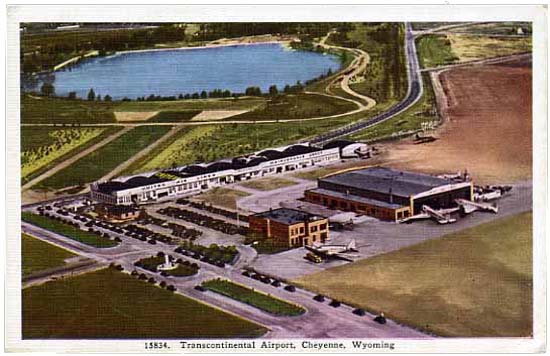
Cheyenne Transcontinental Airport, 1930's
In the 1930's, the Cheyenne Transcontinental Airport was the busiest airport in
the country. Some of the buildings in the view were designed by Cheyenne architect, Frederic Porter, Sr., designer of the
Boyd Building. The art deco terra cotta fountain in front of the terminal building was constructed by
United Airlines in 1934 in memory of early aviation pioneers.
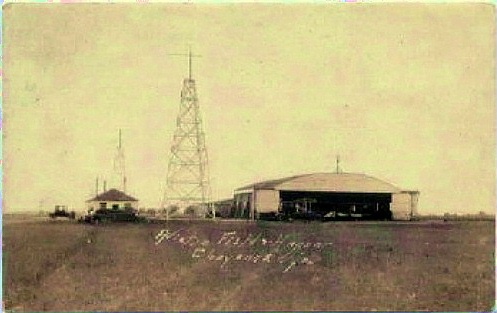
Radio Beacons and Hanger, Cheyenne Transcontinental Airport, 1920's
In 1920, the post office department commenced the long distance carriage of mail by air. Because airplanes of the era were generally limited to achieving an altitude of 9,000 to 10,000 feet, airplanes
going to and from California were fairly well limited to following the same routes as those followed by the
Overland Trail and the Union Pacific Railroad. The limited range of aircraft also required division stations to be established in the
same manner as that followed earlier by the Overland Stage and the railroad. At the division points, the planes could be
refueled and serviced. With establishment of the first airmail routes, Cheyenne was established as the division point between Salt Lake City and
Omaha on the Chicago to San Francisco run. Air service commenced in 1920.
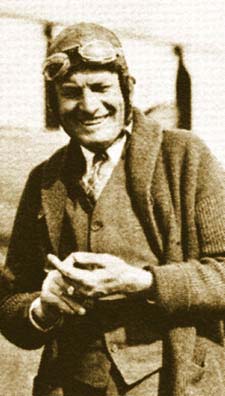 Slim Lewis
Early pilots were guided by visual landmarks observed by leaning out of the cockpit. This gave rise to an
early nickname for a pilot, "Breezo." An early pilot assigned to the Cheyenne Station, Harold T. "Slim" Lewis, commented,
"An instrument panel is just something to clutter up the cockpit and distract your attention from the railroad or riverbed you're following."
In Cheyenne, the principal landmarks for finding the airport were the golden dome of the State House and the
barracks at Ft. D. A. Russell. In 1921, the Post Office published its
PILOTS' DIRECTIONS NEW YORK-SAN FRANCISCO ROUTE.
DISTANCES, LANDMARKS, COMPASS COURSE, EMERGENCY AND REGULAR LANDING FIELDS, WITH SERVICE AND
COMMUNICATION FACILITIES AT PRINCIPAL POINTS ON ROUTE by which the pilots followed the established aerial
route across Wyoming. From Cheyenne two routes were established, a shorter simpler route and one described in the
Directions as Slim Lewis
Early pilots were guided by visual landmarks observed by leaning out of the cockpit. This gave rise to an
early nickname for a pilot, "Breezo." An early pilot assigned to the Cheyenne Station, Harold T. "Slim" Lewis, commented,
"An instrument panel is just something to clutter up the cockpit and distract your attention from the railroad or riverbed you're following."
In Cheyenne, the principal landmarks for finding the airport were the golden dome of the State House and the
barracks at Ft. D. A. Russell. In 1921, the Post Office published its
PILOTS' DIRECTIONS NEW YORK-SAN FRANCISCO ROUTE.
DISTANCES, LANDMARKS, COMPASS COURSE, EMERGENCY AND REGULAR LANDING FIELDS, WITH SERVICE AND
COMMUNICATION FACILITIES AT PRINCIPAL POINTS ON ROUTE by which the pilots followed the established aerial
route across Wyoming. From Cheyenne two routes were established, a shorter simpler route and one described in the
Directions as "about 10 miles farther than the route described previously.
The country over this course is better suited for forced landings, and in case of a forced
landing the pilot is nearer human habitation."
The need for a place to set the plane down upon a forced landing was real. Slim Lewis on one flight from Scotts Bluff to
Cheyenne was forced down four times due to an icing carburetor. After the fourth landing, the last leg of the journey was completed with a
borrowed horse and wagon. The need for emergency fields was recognized. Thus, the Directions noted of
Laramie, "Laramie.-Is the largest town in the valley. Landing fields abound throughout the valley." The absence of sage brush was
an advantage in Wamsutter. The Directions noted: "On the Union Pacific. Fairly good fields
are found between Rawlins and a point 60 miles west. Fields safe to land in show up on
account of the absence of sage brush. The course leaves the railroad where the Union
Pacific tracks loop to the southeast."
At first, there were no night flights. In 1923, the government began construction of illuminated beacons every
twenty miles. Thus, in 1924 Slim Lewis brought in the first night airmail into Cheyenne.
Beginning in 1925, contracts were let, much in the same manner as previously done with stage lines, to private contractors
for the carriage of the mail. In 1927, the San Francisco - Chicago route was awarded to Boeing Air Transport, Inc., a predecessor of today's
United Airlines. At first, the fledgling airline used Boeing Model 40 aircraft which, in addition to the mail, had
room for two passengers. [Writer's comment: Things have not necessarily changed. Some fifty years later, the writer was a passenger
in a mail plane. The plane had room for two paying passengers in the tail. Between the passenger seats and
the pilot and co-pilot was a large pile of mail sacks.]
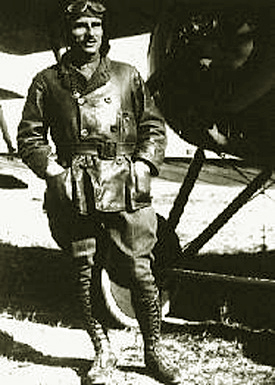 Early airmail pilot Ham Lee Early airmail pilot Ham Lee
Not withstanding that the two passengers of the Boeing Model 40 were in an enclosed cabin with leather seating, the pilot was still in
an open air flight deck above and to the aft of the two passengers. The enclosed cabin had windows which provided a clear view of
the countryside overwhich the machine flew. The wife of Waldo C. Johnson about 1927 flew from
New York to California changing planes in Chicago and Omaha. She therefore became one of the first women to cross the continent in an
aerolane. On the Chicago to Omaha leg of the journey, the pilot was E. Hamilton "Ham" Lee (1892-1994). Mrs. Johnson later wrote that she
was concerned about the pilot:
"The poor pilot had no protection at all and in bad weather it must be realy frightfully cold. It is a
very unsociable way to travel, for you can have no communication at all with your pilot except when you land, but I would
certainly have been frozen in an open plane, for with my windows closed I was almost cold in spite of a seater, a leather coat Ms. Houghton's sheepskin coat, and the
lumbermen's felt boots which I pulled on over my own high ones. * * * I asked Mr. Lee if he wasn't very cold, but he said he had been warned
of a cold wave and had on his furlined flying suit."
From Cheyenne to Salt Lake City, the plane piloted by Halson A. "Colly" Collison encountered severe headwinds. Collison had previously set the
record from Cheyenne to Salt Lake City of two hours twenty-five minutes.
Mrs. Johnson's flight took seven hours. Mrs. Johnson
noted that with bad wind they could not land at Rock Springs and they
had to refuel at emergency stations, one this side, one the other side of Rock Springs. The gasoline was stored in
barrels. "They fil five gallon cans from these," she wrote, "and then haul them up on the ship. It takes half
an hour this way. In the real landing fields, they have overhead hose and they refuel the ship in a
few minutes.' Collison continued to fly for Boeing and later its successor United Airlines. In the early morning hours of
October 7, 1935, United Airlines Flight 4 piloted by Collison was expected in Cheyenne. A routine signal was received from the
the aircraft indicating that the plane was over Silver Crown. Everything was normal. The Cheyenne
radio room responded by giving wind directions and indicated that in landing the plane was to use caution as there was a west-bound plane in Cheyenne.
Flight 4 did not acknowledge. The wreckage was found three miles east of Silver Crown about 10 miles west of Cheyenne on the John Bell
Ranch. There were no survivors.
Nevertheless by the late 1920's, it soon became apparent that there was a demand for passenger service. Boeing then
developed for the run the 12 passenger Wright powered Model 80. This was soon followed by the more powerful and larger
Model 80A on the transcontinental run. The Model 80A constructed of metal spars with an
exterior skin of fabric, was, for the time, humongous with a wing span of 80 feet and a length of over 56 feet.
The plane could carry its 18 passengers in luxurious comfort cruising at 125 miles per hour.
The principal overhaul center for the Model 80A was established in Cheyenne. Thus, Cheyenne became
one of the main centers for air travel in the United States serving passengers flying across the continent, but also serving passengers and
mail running from Montana south to Denver and Pueblo.
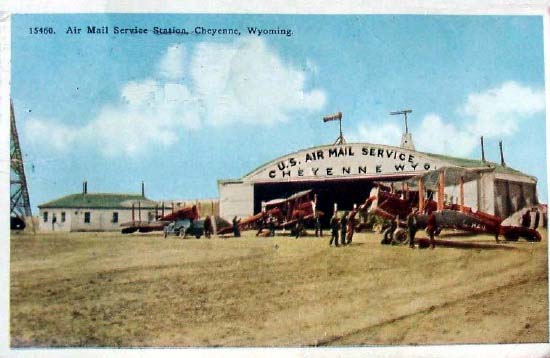
Airmail Planes, Cheyenne Transcontinental Airport, 1927
The Model 80A aircraft, was the height of modern design. A tri-motored biplane, it had an enclosed cabin for the passengers. The cabin, equipped
with leather covered reclining seats and a watercloset with hot and cold running water, was five feet wide. The rows of seats were divided with one seat
on the port side of the craft and two on the starboard side. Each seat had a seperate reading lamp and air vent. The
roar of the three 525-horsepower Pratt & Whitney Hornet radial engines was muffled by sound proofing in the exterior fabric covered cabin walls, permitting passengers
to speak to one another in almost conversational tones. A radio aerial above the cabin assured passengers that the craft was
in touch with a line of radio beacons crossing Wyoming. Other beacons were
established across the state to guide the planes to emergency airmail fields along the way.
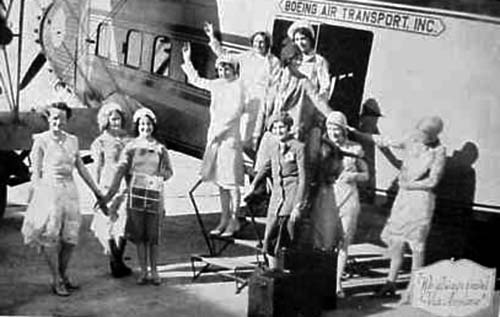
Arriving in Cheyenne for Frontier Days, 1930
The aircraf is a Boeing Model 80A. The use of an enclosed cabin for passengers was not an innovation. As early as 1920, the British-operated Imperial
Airways was using tri-motored DeHavilands with an enclosed cabin to connect the European continent to
Britain and in the late 1920's used such craft to carry the Royal Mail and passengers from
Britain to India. The flight to India took a week but was a savings over the three week passage by ship. The major
innovation, however, of the Model 80's was the introduction of two new features, an enclosed flight deck for
the captain and co-pilot and an onboard registered nurse to attend to the needs of the passengers. On previous aircraft such as the
DeHavilands, the flight deck from which the captain and co-pilot guided the aircraft was outside above the cabin and open to the
elements. Prior to the employment of the registered nurses, it was the duty of the co-pilot to attend to the
needs of the passengers.
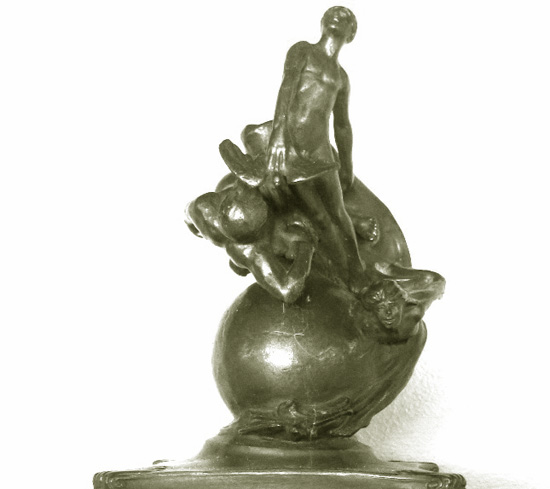
Collier Trophy.
The Robert J. Collier Trophy was established in 1911 and is awarded for significant advances in aviation. The United States
Air Mail Service won the award in 1922 for safety and 1923 for the introduction of night service. The Air Mail Service carried the
trophy to cities along the transcontinental route and put it on display.
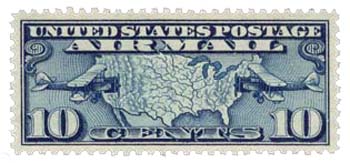 Airmail
stamp, 1927 Airmail
stamp, 1927
The transcontinental flights represented a major savings of time. The Model 80A was, in essence, the Concorde SST of the day. The flight from Chicago to San Francisco took only 20 hours with
stops in Omaha, North Platte, Cheyenne, Rock Springs, Salt Lake City, Elko, Reno, and Sacramento. By train, the same trip
took 3 1/2 days. From San Francisco to New York was only a day and a half by air as compared to 5 days by train.
Nevertheless, flights remained subject to the vagracies of the weather. The daughter of soprano Alma Gluck, freelance magazine writer Marcia
Davenport (1903-1996), wrote in an article "Covered Wagon -- 1932," Good Housekeeping, Ocotober 1932, of her flight from
California to New York. Because of a storm, the plane made an unscheduled landing in Parco (present-day Sinclair). She described the
terminal building in which the passenger waited out the storm as a "little wooley-western shack
on the edge of the field." Because of fog, the plane made another
unscheduled landing in Laramie. When the fog finally lifted, the plane made its ascent over
Sherman Hill and descended into Cheyenne 10 hours late. At Omaha, due to the lateness of the plane, the airline's
caterer forgot to service the plane. Thus, from Omaha to Chicago the only refreshments for
the passengers were tomato juice and sweet buns. Miss Davenport noted that on the
airplane the food was furnished as a part of the fare, while on the train food had to be purchased. She continued,
"To be sure, you get your food regularly, and of luxurious variety, on the railroad; in the air -- you wait and see?"
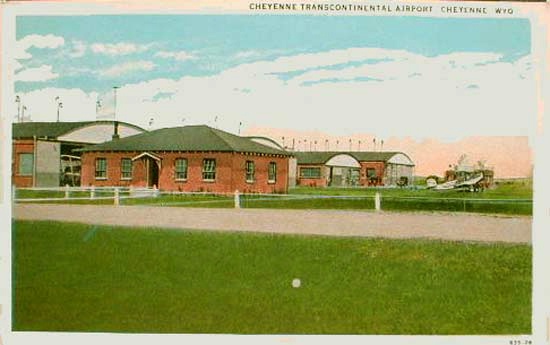
Cheyenne Transcontinental Airport, approx. 1930's.
Following World War II, equipment improved. The DC 4 was capable of flying non-stop from Chicago to California at 18,000 feet.
Thus, Cheyenne was by-passed. United pulled out. Western Airlines discontinued service on the north-south route. Thus,
today what was once the nation's busiest airport is but a way station for commuter airlines, leading to the rumor
that if one dies and goes to Heaven, one will have to change flights in Denver.
Music this page, courtsy Horse Creek Cowboy:
"Come Josephine In My Flying Machine"
Lyrics by Alfred Bryan
Music by Fred Fisher, 1910
Oh, say! Let us fly, dear
Where, kid?
To the sky dear
Oh, you flying machine!
Jump in Miss Josephine
Ship Ahoy!
Oh, joy! What a feeling
Feels cold, thru the ceiling. Ho, high!
Hoopla, we fly! To the sky so high
(Chorus)
Come Josephine, in my flying machine
Going up, she goes! Up she goes!
Balance yourself like a bird on a beam
In the air she goes; there she goes!
Up, up, a little bit higher.
Oh, my! The moon is on fire.
Come, Josephine in my flying machine
Going up, all on, "Goodbye"
(Repeat Chorus)
One, two, now we're off, dear.
Oh, you, pretty soft, dear.
Whoa! Say! Don't hit the moon.
Oh, no, not yet but soon. You for me,
Oh, gee! You're a fly kid.
Not me, I'm a sky kid.
Gee! I'm up in the air about you for fair
(Repeat Chorus)
Next page, Frontier Days.
|